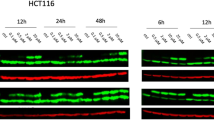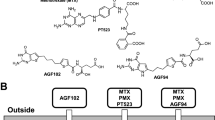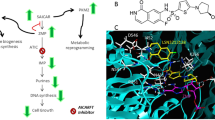Abstract
Purpose: Trifluorothymidine (TFT) is a fluoropyrimidine that is part of the novel combination metabolite TAS-102, in which TFT is combined with a potent thymidine phosphorylase inhibitor (TPI). TAS-102 is currently tested as an orally chemotherapeutic agent in different schedules in a phase I study. In its monophosphate form, TFT can inhibit thymidylate synthase (TS) activity after binding to the TS-nucleotide binding site leading to dTTP depletion, and in its triphosphate form TFT is incorporated into DNA, eventually leading to DNA damage. In this in vitro study, we investigated whether TFT could potentiate cytotoxicity of the antifolate-based TS inhibitors AG337 (Nolatrexed), ZD1694 (Raltitrexed) and GW1843; and whether increased TS inhibition or DNA damage would be related to this result. Methods: The drug combinations were studied in colon cancer cell lines either grown at low or high folate conditions. Multiple drug effect analysis was performed after measuring growth inhibition when the drugs were combined (MTT Assay) and expressed as Combination Index (CI), where CI<0.9 indicates synergism, CI=0.9–1.1 indicates additivity and CI>1.1 indicates antagonism. Drug target analysis was performed using the TS in situ inhibition assay and the FADU DNA-damage assay. Cells were exposed to either the drugs alone or in combination to determine the effect on TS activity and DNA damage induction, respectively. Results: Three experimental procedures were used to test the interaction of the drugs: either one of the drugs was kept at a constant concentration (IC25) or two drugs were added in a 1:1 IC50-based molar ratio. The combinations of TFT with one of the antifolates in which one of the drugs was kept at a constant concentration were synergistic for all antifolates in WiDr/F cells, which grow in low folate medium (CI=0.6–0.8), but only additive to antagonistic for the cell lines growing in high folate medium: TFT-AG337: CI=0.9–2.3; TFT-ZD1694: CI=0.9–1.3; TFT-GW1843: CI=0.8–1.7. The procedure in which the two drugs were added in a 1:1 IC50-based molar ratio showed antagonism for all three combinations in all cell lines (CI>2.7). TS inhibition (14.3%) and DNA damage (8%) were more pronounced than expected (P<0.05) when TFT was combined with GW1843 in WiDr/F cells, in contrast to AG337 and ZD1694, which showed inhibiting effects as expected (additive). Conclusions: The combination of TFT with the antifolates AG337, ZD1694 and GW1843 is mainly additive when the drugs are given simultaneously and this is mediated by an additive TS inhibition and DNA damage. The drug interaction may partly be dependent on the folate homeostasis since WiDr/F cells growing at low folate conditions show pronounced synergism in growth inhibition, two-sided TS inhibition and DNA damage, especially when TFT is combined with the tight-binding TS inhibitor GW1843.





Similar content being viewed by others
References
Peters GJ, van der Wilt CL, Van Moorsel CJ, Kroep JR, Bergman AM, Ackland SP (2000) Basis for effective combination cancer chemotherapy with antimetabolites. Pharmacol Ther 87:227–253
Schmoll HJ, Buchele T, Grothe A, Dempke W (1999) Where do we stand with 5-fluorouracil? Semin Oncol 26:589–605
Pinedo HM, Peters GJ (1988) Fluorouracil: biochemistry and pharmacology. J Clin Oncol 6:1653–1664
Peters GJ, Backus HH, Freemantle S, van Triest B, Codacci-Pisanelli G, van der Wilt CL, Smid K, Lunec J, Calvert AH, Marsh S, McLeod HL, Bloemena E, Meijer S, Jansen G, Van Groeningen CJ, Pinedo HM (2002) Induction of thymidylate synthase as a 5-fluorouracil resistance mechanism. Biochim Biophys Acta 1587:194–205
van Triest B, Peters GJ (1999) Thymidylate synthase: a target for combination therapy and determinant of chemotherapeutic response in colorectal cancer. Oncology 57:179–194
Danenberg PV, Malli H, Swenson S (1999) Thymidylate synthase inhibitors. Semin Oncol 26:621–631
Carreras CW, Santi DV (1995) The catalytic mechanism and structure of thymidylate synthase. Annu Rev Biochem 64:721–762
Takemura Y, Jackman AL (1997) Folate-based thymidylate synthase inhibitors in cancer chemotherapy. Anticancer Drugs 8:3–16
Rustum YM, Harstrick A, Cao S, Vanhoefer U, Yin MB, Wilke H, Seeber S (1997) Thymidylate synthase inhibitors in cancer therapy: direct and indirect inhibitors. J Clin Oncol 15:389–400
Touroutoglou N, Pazdur R (1996) Thymidylate synthase inhibitors. Clin Cancer Res 2:227–243
Jackman AL, Calvert AH (1995) Folate-based thymidylate synthase inhibitors as anticancer drugs. Ann Oncol 6:871–881
Eckstein JW, Foster PG, Finer-Moore J, Wataya Y, Santi DV (1994) Mechanism-based inhibition of thymidylate synthase by 5-(trifluoromethyl)-2′-deoxyuridine 5′-monophosphate. Biochemistry 33:15086–15094
Santi DV, Sakai TT (1971) Thymidylate synthetase. Model studies of inhibition by 5-trifluoromethyl-2′-deoxyuridylic acid. Biochemistry 10:3598–3607
Temmink OH, De Bruin M, Comijn EM, Fukushima M, Peters GJ (2005) Determinants of trifluorothymidine sensitivity and metabolism in colon and lung cancer cells. Anticancer Drugs 16:285–292
Tsuchiya H, Kuwata K, Nagayama S, Yamashita K, Kamiya H, Harashima H (2004) Pharmacokinetic modeling of species-dependent enhanced bioavailability of trifluorothymidine by thymidine phosphorylase inhibitor. Drug Metab Pharmacokinet 19:206–215
Emura T, Nakagawa F, Fujioka A, Ohshimo H, Yokogawa T, Okabe H, Kitazato K (2004) An optimal dosing schedule for a novel combination antimetabolite, TAS-102, based on its intracellular metabolism and its incorporation into DNA. Int J Mol Med 13:249–255
Thomas MB, Hoff PM, Carter S, Bland G, Lassere Y, Wolff R, Xiong H, Hayakawa T, Abbruzzese J (2002) A dose-finding, safety and pharmacokinetics study of TAS-102, an antitumor/antiangiogenic agent given orally on a once-daily schedule for five days every three weeks in patients with solid tumors. Proc Amer Assoc Cancer Res 43:554 (#2754)
Santi DV, Sakai TT (1972) Irreversible inhibition of thymidylate synthetase by 5-formyl-2′-deoxyuridylic acid. Biochem Biophys Res Commun 46:1320–1325
McGuire JJ (2003) Anticancer antifolates: current status and future directions. Curr Pharm Des 9:2593–2613
Webber S, Bartlett CA, Boritzki TJ, Hillard JA, Howland EF, Johnston AL, Kosa M, Margosiak SA, Morse CA, Shetty BV (1996) AG337, a novel lipophilic thymidylate synthase inhibitor: in vitro and in vivo preclinical studies. Cancer Chemother Pharmacol 37:509–517
Rafi I, Taylor GA, Calvete JA, Boddy AV, Balmanno K, Bailey N, Lind M, Calvert AH, Webber S, Jackson RC (1995) Clinical pharmacokinetic and pharmacodynamic studies with the nonclassical antifolate thymidylate synthase inhibitor 3,4-dihydro-2-amino-6-methyl-4-oxo-5-(4-pyridylthio)-quinazolone dihydrochloride (AG337) given by 24-hour continuous intravenous infusion. Clin Cancer Res 1:1275–1284
Jackman AL, Taylor GA, Gibson W, Kimbell R, Brown M, Calvert AH, Judson IR, Hughes LR (1991) ICI D1694, a quinazoline antifolate thymidylate synthase inhibitor that is a potent inhibitor of L1210 tumor cell growth in vitro and in vivo: a new agent for clinical study. Cancer Res 51:5579–5586
Schwartz G, Johnson TR, Goetz A, Burris H, Smetzer L, Lampkin T, Sailstad J, Hohneker JA, Von Hoff DD, Rowinsky EK (2001) A phase I and pharmacokinetic study of 1843U89, a noncompetitive inhibitor of thymidylate synthase, in patients with advanced solid malignancies. Clin Cancer Res 7:1901–1911
Hanlon MH, Ferone R (1996) In vitro uptake, anabolism, and cellular retention of 1843U89 and other benzoquinazoline inhibitors of thymidylate synthase. Cancer Res 56:3301–3306
Westerhof GR, Kathmann I, Jackman AL, Rosowsky A, Forsch RA, Hynes JB, Boyle FT, Peters GJ, Pinedo HM (1995) Carrier- and receptor-mediated transport of folate antagonists targeting folate-dependent enzymes: correlates of molecular-structure and biological activity. Mol Pharmacol 48:459–471
van der Wilt CL, Kuiper CM, Peters GJ (1999) Combination studies of antifolates with 5-fluorouracil in colon cancer cell lines. Oncol Res 11:383–391
Caponigro F, Avallone A, Budillon A, Comella P, Comella G (2001) Raltitrexed/5-fluorouracil-based combination chemotherapy regimens in anticancer therapy. Anticancer Drugs 12:489–497
Webley SD, Welsh SJ, Jackman AL, Aherne GW (2001) The ability to accumulate deoxyuridine triphosphate and cellular response to thymidylate synthase (TS) inhibition. Br J Cancer 85:446–452
Aherne GW, Hardcastle A, Raynaud F, Jackman AL (1996) Immunoreactive dUMP and TTP pools as an index of thymidylate synthase inhibition; effect of tomudex (ZD1694) and a nonpolyglutamated quinazoline antifolate (CB30900) in L1210 mouse leukaemia cells. Biochem Pharmacol 51:1293–1301
Emura T, Suzuki N, Yamaguchi M, Ohshimo H, Fukushima M (2004) A novel combination antimetabolite, TAS-102, exhibits antitumor activity in FU-resistant human cancer cells through a mechanism involving FTD incorporation in DNA. Int J Oncol 25:571–578
Peters GJ, van Triest B, Backus HH, Kuiper CM, van der Wilt CL, Pinedo HM (2000) Molecular downstream events and induction of thymidylate synthase in mutant and wild-type p53 colon cancer cell lines after treatment with 5-fluorouracil and the thymidylate synthase inhibitor raltitrexed. Eur J Cancer 36:916–924
McGinn CJ, Pestalozzi BC, Drake JC, Glennon MC, Kunugi K, Otterson G, Allegra CJ, Johnston PG, Kinsella TJ (2000) Cell cycle regulation of the G0/G1 transition in 5-fluorouracil-sensitive and -resistant human colon cancer cell lines. Cancer J 6:234–242
van Triest B, Pinedo HM, van Hensbergen Y, Smid K, Telleman F, Schoenmakers PS, van der Wilt CL, van Laar JA, Noordhuis P, Jansen G, Peters GJ (1999) Thymidylate synthase level as the main predictive parameter for sensitivity to 5-fluorouracil, but not for folate-based thymidylate synthase inhibitors, in 13 nonselected colon cancer cell lines. Clin Cancer Res 5:643–654
van der Wilt CL, Smid K, Aherne GW, Noordhuis P, Peters GJ (1997) Biochemical mechanisms of interferon modulation of 5-fluorouracil activity in colon cancer cells. Eur J Cancer 33:471–478
Xu JM, Song ST, Tang ZM, Liu XQ, Jiang ZF, Zhou L, Li YB, Huang Y (1998) Evaluation of in vitro chemosensitivity of antitumor drugs using the MTT assay in fresh human breast cancer. Breast Cancer Res Treat 49:251–259
Keepers YP, Pizao PE, Peters GJ, Ark-Otte J, Winograd B, Pinedo HM (1991) Comparison of the sulforhodamine B protein and tetrazolium (MTT) assays for in vitro chemosensitivity testing. Eur J Cancer 27:897–900
Chou TC, Talalay P (1984) Quantitative analysis of dose-effect relationships: the combined effects of multiple drugs or enzyme inhibitors. Adv Enzyme Regul 22:27–55
Xu JM, Azzariti A, Colucci G, Paradiso A (2003) The effect of gefitinib (Iressa, ZD1839) in combination with oxaliplatin is schedule-dependent in colon cancer cell lines. Cancer Chemother Pharmacol 52:442–448
Yalowich JC, Kalman TI (1985) Rapid determination of thymidylate synthase activity and its inhibition in intact L1210 leukemia cells in vitro. Biochem Pharmacol 34:2319–2324
Rots MG, Pieters R, Kaspers GJ, van Zantwijk CH, Noordhuis P, Mauritz R, Veerman AJ, Jansen G, Peters GJ (1999) Differential methotrexate resistance in childhood T- versus common/preB-acute lymphoblastic leukemia can be measured by an in situ thymidylate synthase inhibition assay, but not by the MTT assay. Blood 93:1067–1074
Birnboim HC, Jevcak JJ (1981) Fluorometric method for rapid detection of DNA strand breaks in human white blood cells produced by low doses of radiation. Cancer Res 41:1889–1892
Sigmond J, Backus HH, Wouters D, Temmink OH, Jansen G, Peters GJ (2003) Induction of resistance to the multitargeted antifolate Pemetrexed (ALIMTA) in WiDr human colon cancer cells is associated with thymidylate synthase overexpression. Biochem Pharmacol 66:431–438
van der Wilt CL, Smid K, Peters GJ (2002) Effects of antifolates on the binding of 5-fluoro-2′-deoxyuridine monophosphate to thymidylate synthase. Biochem Pharmacol 64:669–675
Backus HH, Pinedo HM, Wouters D, Padron JM, Molders N, van Der Wilt CL, van Groeningen CJ, Jansen G, Peters GJ (2000) Folate depletion increases sensitivity of solid tumor cell lines to 5-fluorouracil and antifolates. Int J Cancer 87:771–778
Peters GJ, Smitskamp-Wilms E, Smid K, Pinedo HM, Jansen G (1999) Determinants of activity of the antifolate thymidylate synthase inhibitors Tomudex (ZD1694) and GW1843U89 against mono- and multilayered colon cancer cell lines under folate-restricted conditions. Cancer Res 59:5529–5535
Radparvar S, Houghton PJ, Houghton JA (1988) Characteristics of thymidylate synthase purified from a human colon adenocarcinoma. Arch Biochem Biophys 260:342–350
Temmink OH, Comijn EM, Fukushima M, Peters GJ (2004) Intracellular thymidylate synthase inhibition by trifluorothymidine in FM3A cells. Nucleosides, Nucleotides and Nucleic Acids 23:1491–1494
Duch DS, Banks S, Dev IK, Dickerson SH, Ferone R, Heath LS, Humphreys J, Knick V, Pendergast W, Singer S (1993) Biochemical and cellular pharmacology of 1843U89, a novel benzoquinazoline inhibitor of thymidylate synthase. Cancer Res 53:810–818
Weichsel A, Montfort WR, Ciesla J, Maley F (1995) Promotion of purine nucleotide binding to thymidylate synthase by a potent folate analogue inhibitor, 1843U89. Proc Natl Acad Sci USA 92:3493–3497
Longo GS, Izzo J, Chang YM, Tong WP, Zielinski Z, Gorlick R, Chou TC, Bertino JR (1998) Pretreatment of colon carcinoma cells with Tomudex enhances 5-fluorouracil cytotoxicity. Clin Cancer Res 4:469–473
Desjardins J, Emerson DL, Colagiovanni DB, Abbott E, Brown EN, Drolet DW (2004) Pharmacokinetics, safety, and efficacy of a liposome encapsulated thymidylate synthase inhibitor, OSI-7904L [(S)-2-[5-[(1,2-dihydro-3-methyl-1-oxobenzo[f]quinazolin-9-yl)methyl]amino-1-oxo-2-isoindolynl]-glutaric acid] in mice. J Pharmacol Exp Ther 309:894–902
Hazarika M, White RM, Johnson JR, Pazdur R (2004) FDA drug approval summaries: pemetrexed (Alimta). Oncologist 9:482–488
Acknowledgements
This study was supported by Taiho Pharmaceutical Co., Ltd., Tokushima, Japan.
Author information
Authors and Affiliations
Corresponding author
Rights and permissions
About this article
Cite this article
Temmink, O.H., Hoogeland, M.F.M., Fukushima, M. et al. Low folate conditions may enhance the interaction of trifluorothymidine with antifolates in colon cancer cells. Cancer Chemother Pharmacol 57, 171–179 (2006). https://doi.org/10.1007/s00280-005-0033-4
Received:
Accepted:
Published:
Issue Date:
DOI: https://doi.org/10.1007/s00280-005-0033-4




